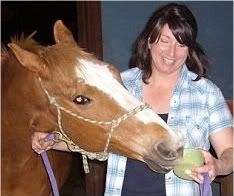Post by pokicowgirl on Mar 5, 2009 11:47:42 GMT -5
LOUISVILLE, Ky. - Churchill Downs Inc. on Monday announced a comprehensive set of new and previously established safety rules that will go into effect at the upcoming spring meet at the company's flagship track, with the same rules being applied to all company tracks by the start of their respective 2010 meets.
The rules essentially run the gamut of safety and welfare for horses and jockeys. Many were spawned from CDI's "Safety From Start to Finish" initiative that was sparked in large part by the death of Eight Belles in the Kentucky Derby last year.
Among the new rules that will be in place:
* Independent, standardized, third-party testing and monitoring of track surfaces by Dr. Mick Peterson, a University of Maine professor of mechanical engineering.
* "Supertesting" of all winning horses for more than 100 performance-enhancing drugs. These are a series of highly sophisticated tests recommended by the Thoroughbred Owners and Breeders Association.
* The freezing and storage of equine blood and urine samples to allow for retrospective testing, in case tests are developed in the future for drugs that currently are undetectable. This initiative is being funded by The Jockey Club, and other racetracks are also participating.
* Barring any horse that has not reached its actual second birthday from racing. This supercedes the traditional rule that considered all horses to have been born on Jan. 1 for the purpose of competition.
* Reduction of the maximum number of starters in 4 1/2-furlong dirt races from 12 to 10.
* Prohibition of the transport of horses from CDI facilities for slaughter. Suffolk Downs in Massachusetts was the first to implement such a policy last year.
Including the new rules, 22 bullet points are listed as safety initiatives. Ongoing safety measures that are listed include the following: the banning of steroids; the banning of horseshoes, such as front toe-grabs, considered to be unsafe; the use of low-impact riding whips with limited usage rules; an improved presence of on-site medical personnel and equipment for both horses and humans; online access to jockey medical histories for emergency medical personnel; and mandatory necropsies of any horse that dies while racing or training.
Many of the Churchill rules mirror the recommendations of the National Thoroughbred Racing Association's new Safety and Integrity Alliance program, which was formed in October principally in response to widespread criticism and scrutiny of horse racing following the Eight Belles tragedy.
"As in all sports, there's an inherent safety risk involved in horse racing," Churchill general manager Jim Gates said Monday. "We firmly believe the measures and policies we've put in place will help to minimize that risk and better ensure the safety and well-being of our athletes."
Besides Churchill, the other company racetracks to be affected by the new rules are Fair Grounds in New Orleans, Calder in Miami, and Arlington Park near Chicago
The rules essentially run the gamut of safety and welfare for horses and jockeys. Many were spawned from CDI's "Safety From Start to Finish" initiative that was sparked in large part by the death of Eight Belles in the Kentucky Derby last year.
Among the new rules that will be in place:
* Independent, standardized, third-party testing and monitoring of track surfaces by Dr. Mick Peterson, a University of Maine professor of mechanical engineering.
* "Supertesting" of all winning horses for more than 100 performance-enhancing drugs. These are a series of highly sophisticated tests recommended by the Thoroughbred Owners and Breeders Association.
* The freezing and storage of equine blood and urine samples to allow for retrospective testing, in case tests are developed in the future for drugs that currently are undetectable. This initiative is being funded by The Jockey Club, and other racetracks are also participating.
* Barring any horse that has not reached its actual second birthday from racing. This supercedes the traditional rule that considered all horses to have been born on Jan. 1 for the purpose of competition.
* Reduction of the maximum number of starters in 4 1/2-furlong dirt races from 12 to 10.
* Prohibition of the transport of horses from CDI facilities for slaughter. Suffolk Downs in Massachusetts was the first to implement such a policy last year.
Including the new rules, 22 bullet points are listed as safety initiatives. Ongoing safety measures that are listed include the following: the banning of steroids; the banning of horseshoes, such as front toe-grabs, considered to be unsafe; the use of low-impact riding whips with limited usage rules; an improved presence of on-site medical personnel and equipment for both horses and humans; online access to jockey medical histories for emergency medical personnel; and mandatory necropsies of any horse that dies while racing or training.
Many of the Churchill rules mirror the recommendations of the National Thoroughbred Racing Association's new Safety and Integrity Alliance program, which was formed in October principally in response to widespread criticism and scrutiny of horse racing following the Eight Belles tragedy.
"As in all sports, there's an inherent safety risk involved in horse racing," Churchill general manager Jim Gates said Monday. "We firmly believe the measures and policies we've put in place will help to minimize that risk and better ensure the safety and well-being of our athletes."
Besides Churchill, the other company racetracks to be affected by the new rules are Fair Grounds in New Orleans, Calder in Miami, and Arlington Park near Chicago



